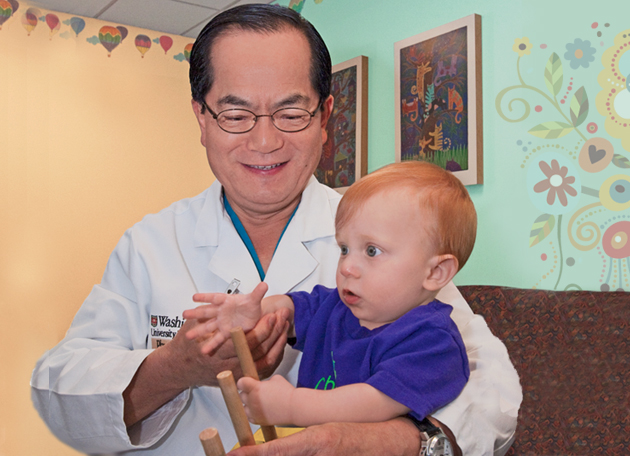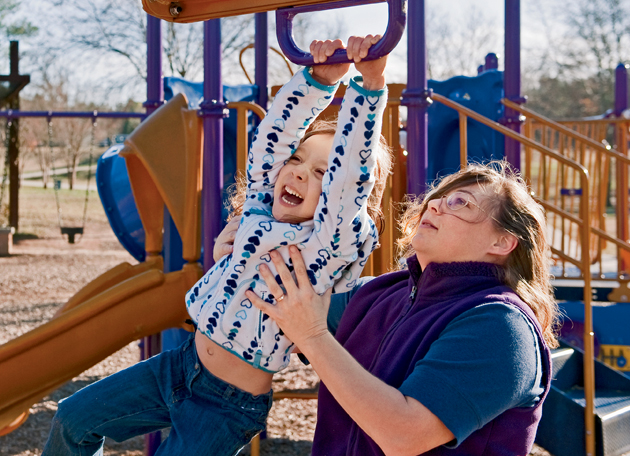
Like parents everywhere, Martin and Jennifer Wagner resisted the thought that something could be wrong with their child. When their pediatrician observed that the couple’s 18-month-old daughter, Bailey, might have cerebral palsy (CP), their immediate reaction was denial. “No parents want to admit that their child is less than perfect,” Jen says. A neurologist confirmed the diagnosis, and then after about a year, she suggested an apparently radical surgery as a treatment. The Wagners’ reaction: “No way. She can walk; she has no mental impairment.”
But then they learned of spastic CP’s effects — loss of motor control, persistent muscle tightness and the potential for long-term complications including arthritis — and their thinking changed. Wanting only the best for Bailey, the couple reconsidered selective dorsal rhizotomy (SDR) as a treatment.
Although the SDR surgery was available near their home in Georgia, the Wagners chose to work with neurological surgeon T. S. Park, MD, at the Washington University Center for Cerebral Palsy Spasticity at St. Louis Children’s Hospital. “This involved travel, but nobody else made us feel as comfortable,” Jen says. “And the statistics were clear. No one else had done nearly as many of the operations, and all without complications.”
“I look for the underlying potential,” says T. S. Park, MD. “The goal is to remove spasticity to improve the quality of life for the rest of their lives.” An honest prediction is a “huge relief” for most patients and families, he says.
A video evaluation shot to Park’s specifications showed Bailey to be a good candidate, and when she was just past her third birthday, the family traveled to St. Louis for her SDR surgery.
Before Park undertakes the technically demanding neurological surgery, he uses the experience gained performing the operation more than 2,000 times on patients from 46 states and 42 foreign countries to evaluate each candidate. He insists that his patients have access to the intensively rehabilitative physical therapy that is required for success, and he likes to be assured that patients “will work hard to walk independently,” he says. He employs a scoring system to set a goal for the surgery and let patients and their families know realistically what they can expect post-recovery.
“I look for the underlying potential,” Park says. “The goal is to remove spasticity to improve the quality of life for the rest of their lives.” An honest prediction is a “huge relief” for most patients and families, says Park, the Shi H. Huang Professor of Neurological Surgery at the School of Medicine and neurosurgeon-in-chief at St. Louis Children’s Hospital.
The SDR procedure, as refined by Park, begins by removing a small piece of bone from a single vertebra in the patient’s lower back — called a single level laminectomy — and exposing the spinal cord. By applying electrical and mechanical stimuli, Park isolates the sensory nerves from the motor nerves. He then tests the sensory nerves to evaluate their contributions to muscle spasticity.
In CP, Park explains, neurons in the spinal cord that normally are under the brain’s direction become autonomous and overexcited, resulting in a loss of muscle control. By cutting a carefully determined number of the abnormal sensory nerves, spasticity can be reduced or eliminated. The nerves don’t regenerate, so the solution is permanent. Surprisingly, Park says, no loss of sensation results. The spinal membrane is closed over the nerves, but the bone is not replaced; in younger patients, it regenerates. The operation can be applied in cases of spastic CP affecting both legs (spastic diplegia), one leg (spastic hemiplegia) or in mild cases that involve both legs and both arms (spastic quadriplegia).
The procedure originally involved opening five or six vertebrae to locate the appropriate nerves. But in 1991, Park developed the less invasive technique of gaining access via just a single vertebra lower in the back. Although the surgical field is smaller — sometimes no more than 1 inch square — and the operation is therefore more technically challenging, the effect on the patient’s spinal stability is greatly reduced. The reduction in effect on the spine has made the operation accessible for older patients — up to age 40 — who could not tolerate a massively destabilized spine.
Almost single-handedly, Park has demonstrated the efficacy and safety of the SDR surgery. “His findings are absolutely fundamental and influential,” says Ralph G. Dacey Jr., MD, the Henry G. & Edith R. Schwartz Professor and chairman of neurological surgery at Washington University. “He is one of the few people in the world to have perfected the technical aspects of this procedure, and he has systematically studied its effectiveness and role in the overall treatment of CP.”
n a 2006 paper, Park reported his results comparing children without disabilities with two groups of children with CP — those treated with intensive physical therapy alone and those who underwent SDR and then rehabilitative physical therapy. The children with CP never attained the same strength and movement as those without CP. Yet, the results showed that SDR was an effective treatment and superior to physical therapy alone, offering reliable gains in strength, gait speed and overall gross motor function. Park also reports that in more than 2,000 surgeries, there has not been a single neurological complication, though a few patients have required spinal fusion.
Those results attract patients from around the world and fuel an active Facebook community of more than 1,200 members who exchange information and support. They blog about their experiences, and more than 80 grateful patients have posted videos on the site.
Park is now working with Matthew B. Dobbs, MD, associate professor of orthopaedic surgery, to develop a protocol for combining SDR with percutaneous release surgery to relieve muscles that remain too tight as a result of extended spasticity. (In Bailey’s case, she had heel cord lengthening surgery last fall, which will allow her to keep her heels down as she walks.) Park also is conducting long-term outcomes research to determine how SDR patients do five and 10 years post-surgery.
After 20 years of National Institutes of Health funding for his SDR research, Park recently acquired a substantial private grant to pursue a better understanding of treatments for syringomyelia — damage to the spinal cord as a result of a fluid-filled cyst. A national registry and a consortium of 25 medical centers are contributing to comparative research on the outcomes of various treatments for the disorder.
Surgical Wonders Change Lives
In other work, Park pursues treatment and an understanding of brachial plexus palsy, arm weakness or paralysis usually caused by a traumatic birth injury in which the baby’s shoulders are trapped in the birth canal. The brachial plexus, a complex of nerves that controls the muscles of the shoulder, arms and hands, is located on the side of the neck above the collarbone. As many as 90 percent of patients recover most of their strength with therapy alone and show progress in the first three months of their lives.
For those who do not, Park established the Brachial Plexus Center, where he surgically incises the damaged nerves, harvests undamaged nerves from the tiny patients’ calves, and performs a nerve graft to directly repair the brachial plexus. He prefers to operate on patients at about 7 months of age but has good success in patients up to 18 months. With more than 180 successful operations completed, his team works with orthopaedic surgeons to correct deformities that can occur later.
“Bailey doesn’t know that anything was wrong,” Jen says. “She falls, but now she gets back up. Dr. Park changed her life, and I hope he knows what a difference he makes.”
The surgery can help children with severe shoulder and upper arm weakness achieve functional range of motion in about 70 percent of cases, though it doesn’t often make the affected arm as strong as an unaffected arm. However, Park says, “We can help children to overcome what would be a lifelong disability.”
And this intent underlies all of Park’s practice, research and innovation. In the example of young Bailey Wagner, now 5 years old and finished with her intense initial rehabilitation, there is still “a touch of spasticity,” her mom says. But she is in mainstream preschool, participates in dance class, rides her bike, and swims. Horseback riding therapy helps her with balance and core strength. “Bailey doesn’t know that anything was wrong,” Jen says. “She falls, but now she gets back up. Dr. Park changed her life, and I hope he knows what a difference he makes.”
For more information, visit http://www.stlouischildrens.org/content/medservices/SDR/default.htm or http://brachialplexus.wustl.edu/top.html.
Steve Kohler is a freelance writer based in Bonne Terre, Mo.




Comments and respectful dialogue are encouraged, but content will be moderated. Please, no personal attacks, obscenity or profanity, selling of commercial products, or endorsements of political candidates or positions. We reserve the right to remove any inappropriate comments. We also cannot address individual medical concerns or provide medical advice in this forum.